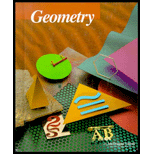
Concept explainers
To explain:A glide reflection is an isometry.
Answer to Problem 19WE
A glide reflection is an isometry.
Explanation of Solution
Given information :
There is a glide reflection transformation.
Concept used:
In 2-dimensional geometry, a glide reflection is a symmetry operation that consists of a reflection over a line and then translation along that line, combined into a single operation.
A translation moves ("slides") an object a fixed distance in a given direction without changing its size or shape, and without turning it or flipping it.The original object is called the pre-image, and the translation is called the image.
An isometry of the plane is a linear transformation which preserves length.If a plane isometry has more than one fixed point, it must be either the identity transformation or a reflection. Every isometry of period two (two applications of the transformation preserving lengths in the original configuration) is either a reflection or a half-turn rotation. Every isometry in the plane is the product of at most three reflections (at most two if there is a fixed point).
Since translations and reflections are both isometries, a glide reflection is also an isometry. (The composition of isometries is an isometry.)
i.e.
Glide reflection is composition of glide & reflection where translation & reflection are isometric since after translation the length or the distance remains the same.
Hence,
A glide reflection is an isometry.
Chapter 14 Solutions
McDougal Littell Jurgensen Geometry: Student Edition Geometry
Additional Math Textbook Solutions
Elementary Statistics: Picturing the World (7th Edition)
Elementary Statistics
Calculus: Early Transcendentals (2nd Edition)
A Problem Solving Approach To Mathematics For Elementary School Teachers (13th Edition)
Introductory Statistics
Algebra and Trigonometry (6th Edition)
- 6arrow_forwardDoor 87.5in to 47 living 44.75 Closet 96in Window ISS.Sin 48in Train Table 96in 48in 132:2 Windowarrow_forward39 Two sides of one triangle are congruent to two sides of a second triangle, and the included angles are supplementary. The area of one triangle is 41. Can the area of the second triangle be found?arrow_forward
 Elementary Geometry For College Students, 7eGeometryISBN:9781337614085Author:Alexander, Daniel C.; Koeberlein, Geralyn M.Publisher:Cengage,
Elementary Geometry For College Students, 7eGeometryISBN:9781337614085Author:Alexander, Daniel C.; Koeberlein, Geralyn M.Publisher:Cengage, Elementary Geometry for College StudentsGeometryISBN:9781285195698Author:Daniel C. Alexander, Geralyn M. KoeberleinPublisher:Cengage Learning
Elementary Geometry for College StudentsGeometryISBN:9781285195698Author:Daniel C. Alexander, Geralyn M. KoeberleinPublisher:Cengage Learning

